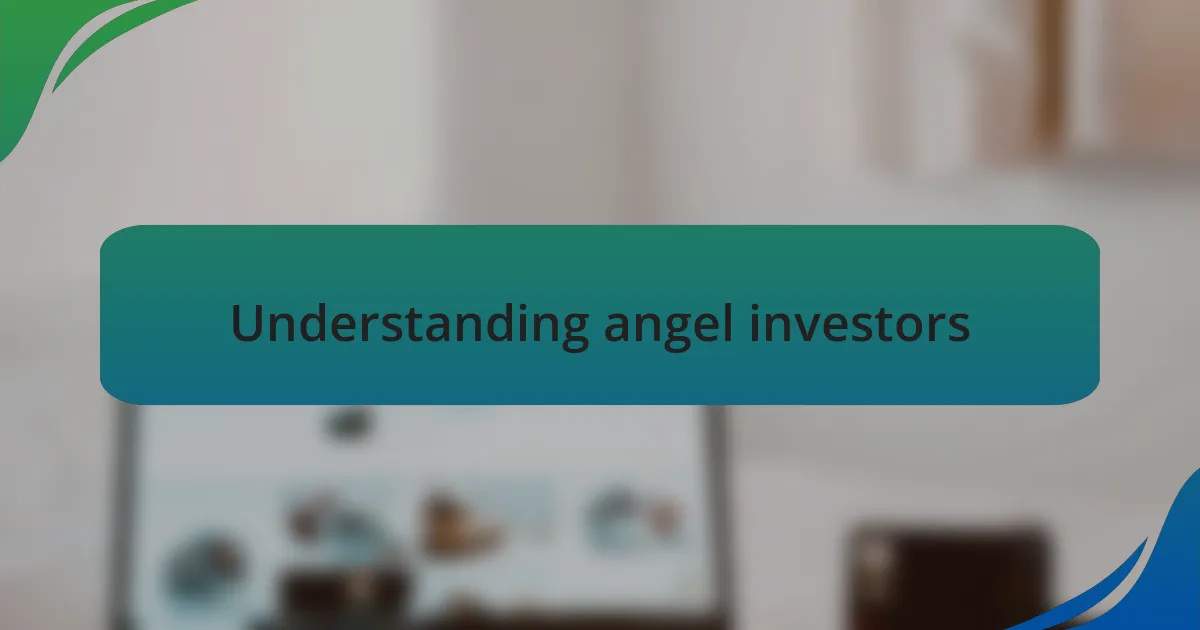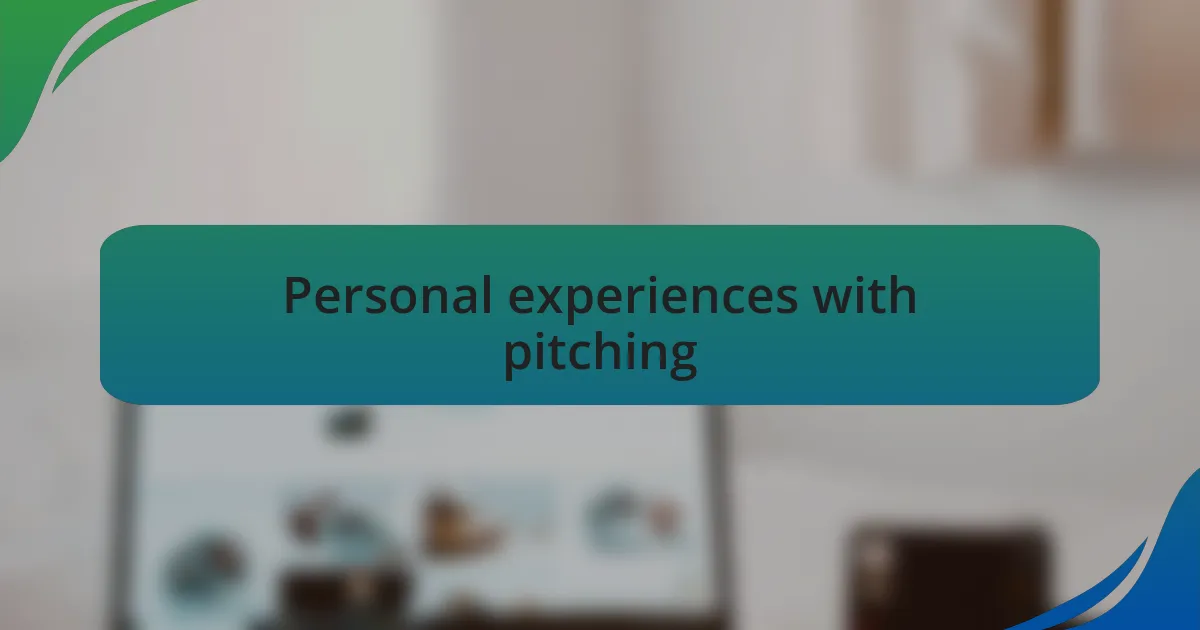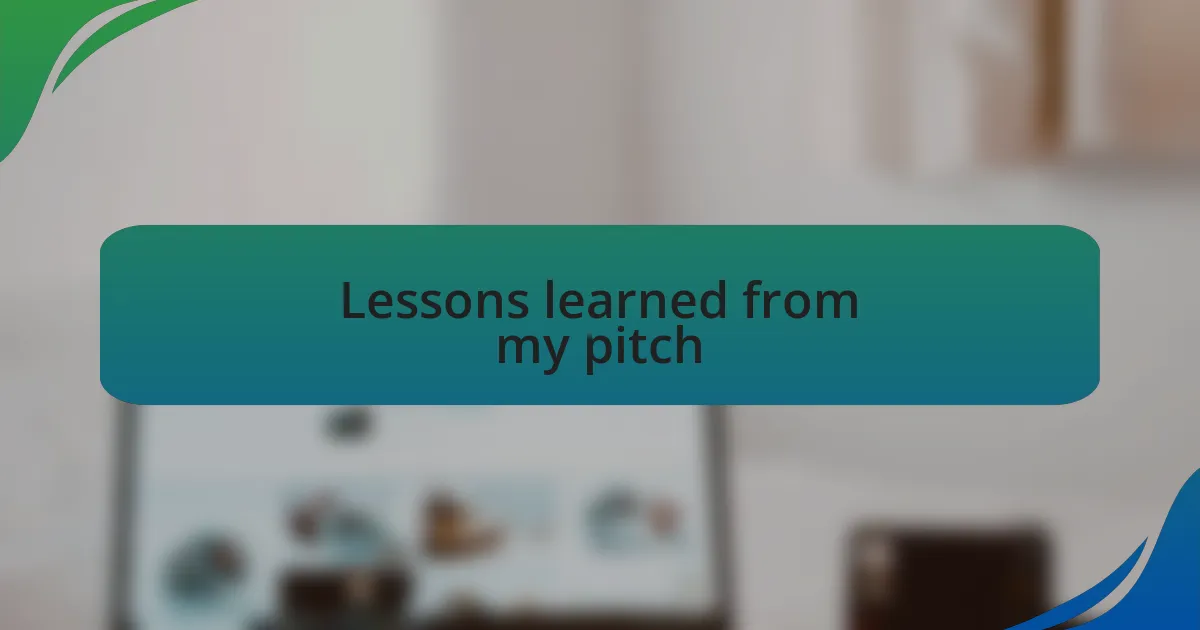Key takeaways:
- Angel investors provide not only capital but also mentorship and industry connections, emphasizing relationship-building in pitches.
- Crafting a clear, compelling narrative and practicing delivery are crucial for engaging investors effectively.
- Connecting with investors through personal stories can enhance relatability and strengthen the pitch.
- Tailoring presentations to the audience and maintaining communication post-pitch can open opportunities for future partnerships.

Understanding angel investors
Angel investors are typically affluent individuals who provide capital to startups in exchange for ownership equity or convertible debt. Based on my experience, they often bring more than just funds to the table; they can offer valuable mentorship and industry connections that can help a fledgling business navigate the tricky startup landscape. Have you ever wondered how much a wise word from the right person can influence a new venture?
I remember my first encounter with an angel investor vividly. It wasn’t just a financial transaction; it felt almost like a partnership. The investor was genuinely interested in my vision and asked probing questions that challenged my assumptions. This connection transformed my approach to pitching; it was about creating a shared journey rather than simply seeking money.
Many angel investors are motivated by the desire to support innovation in industries they are passionate about. This emotional investment can influence their decision-making process. Isn’t it fascinating to think that when they see potential in your idea, it’s often tied to their own dreams and aspirations? Understanding this perspective not only helps in crafting your pitch but also in building a genuine connection that resonates beyond just business.

Preparing your business pitch
When preparing your business pitch, it’s crucial to distill your core message into a clear, compelling narrative. I recall spending hours refining my pitch, focusing on what truly mattered—my business’s mission and its potential impact. Have you ever tried boiling down your entire business idea into just a few sentences? It can be challenging, but clarity is essential to grab and hold attention.
Structuring your presentation is another key element. I learned the hard way that a well-organized pitch not only showcases professionalism but also makes it easier for investors to follow along. I often start with the problem my business solves, followed by my unique solution, and then highlight my go-to-market strategy. By framing my pitch in a familiar narrative, I found it much easier to engage my audience. Can you see how a story can make numbers and facts far more relatable?
Finally, practice is your best friend. In my experience, rehearsing my pitch allowed me to speak confidently and fluidly, turning nerves into enthusiasm. I used to practice in front of friends and family, seeking their feedback to refine my delivery. Have you thought about performing in front of a supportive audience, or even in front of the mirror? It transforms your interaction with potential investors from a daunting task into an exciting opportunity.

Personal experiences with pitching
When I first pitched to angel investors, I was overwhelmed with both excitement and anxiety. I vividly remember standing in front of a small group, sweat trickling down my back as I realized I had forgotten a key statistic that could have reinforced my argument. It’s a powerful reminder of how crucial it is to prepare for every detail—no question should catch you off guard.
In another experience, I found that storytelling worked wonders in connecting with my audience. I shared a personal journey about how my passion for sustainable living led to the birth of my business. The way their expressions changed, nodding along as they engaged with my narrative, made me realize that people invest in people, not just ideas. Have you considered how your own story could resonate with potential investors?
There was also a moment during a pitch when I encountered a tough question that made me stutter. Instead of panicking, I took a breath and embraced the challenge, turning it into a dialogue. That turned out to be a game-changer; it not only showcased my ability to think on my feet but also humanized the experience. Have you thought about how embracing vulnerability can actually strengthen your connection with investors?

Lessons learned from my pitch
One key lesson I learned was the importance of knowing my audience. During one particular pitch, I focused too much on technical jargon, thinking it would impress the investors. Instead, their eyes glazed over, and I quickly realized that simplifying my language made my ideas more accessible and engaging. Have you ever tried to impress by overselling your knowledge and missed connecting with your audience?
Another revelation came when I realized the significance of practice. In my enthusiasm, I thought I could wing it, but I stumbled over my words and lost track of my main points. After that experience, I dedicated time to rehearsing my pitch multiple times. I now see practice not just as repetition but as a way to build confidence and clarity. How often do you remind yourself that preparation can dramatically affect your performance?
Lastly, I discovered the power of follow-up. After my pitch, I sent personalized thank-you emails to each investor, highlighting specific aspects of our conversation. To my surprise, several of them responded positively, wanting to learn more about my venture. This taught me that maintaining relationships is vital in the entrepreneurial journey. Have you considered how a simple thank you can open doors for future opportunities?

Tips for future pitches
When preparing for future pitches, I find it essential to tailor my presentation to the specific investors I’m addressing. I once pitched to a group focused on sustainable products, and I quickly understood that integrating environmental impacts into my project’s narrative resonated deeply with them. Have you considered how aligning your message with investors’ values can enhance your attractiveness?
One strategy I’ve adopted is to create a compelling story around my venture. I remember when I took a simple idea and built a narrative around the challenges I faced and the vision I had. This emotional connection captivated my audience far more than stats and figures ever could. Isn’t it fascinating how storytelling can transform numbers into a relatable experience?
Additionally, the importance of conciseness cannot be overstated. Early in my pitching endeavors, I often drowned my audience in details, but I soon learned that clarity and brevity keep investors engaged. I now aim to distill my core message down to a few impactful sentences. How much stronger can your pitch be if you focus on the essence of your vision?